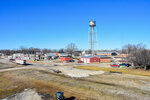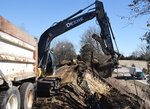BELLE — Belle community member Jimmy Zumwalt arranged a Rock Island Trail meeting on Jan. 29 between Ron Bench from Missouri State Parks (MSP), Archer-Elgin Engineering’s Jeff Meadows and …
This item is available in full to subscribers.
We have recently launched a new and improved website. To continue reading, you will need to either log into your subscriber account, or purchase a new subscription.
If you are a current print subscriber, you can set up a free website account by clicking here.
Otherwise, click here to view your options for subscribing.
Please log in to continue |
|



BELLE — Belle community member Jimmy Zumwalt arranged a Rock Island Trail meeting on Jan. 29 between Ron Bench from Missouri State Parks (MSP), Archer-Elgin Engineering’s Jeff Meadows and Mayor Pro Tem Pudd Mitchell to discuss the future of a $174,000 trails grant to complete the one-mile track through the city limits.
The first question regarding the Rock Island Trail grant’s deadline and requirements was uncertain.
“It didn’t have a lot of detail in it,” Meadows said. “We weren’t involved in that. I do have a copy of it.”
Bench said the requirements for the funds to be spent were water, a kiosk, and parking.
“Our specks on the kiosk would be up to the city, it wouldn’t have to be our exact design,” Bench said. “We would put jersey barriers up to keep cars off the trail.”
Zumwalt confirmed that MSP would purchase the barriers and that no fencing was included in the grant.
“What we would usually do, you have a parking lot up here and the trail is going to go right past there, usually we would put a wooden rail fence to keep people from parking on it or from backing into a cyclist,” Bench said. “If that is not part of the grant, I think it is something (MSP) would probably take care of. The rest of the time we use a bollard system in the city limits. We just want to keep people from driving down the trail.”
Bollards are not required to be installed at private intersections. Zumwalt added some drainage issues along the trail need to be addressed.
Zumwalt expressed concerns about the narrow right-of-way and Bench said in most places the right-of-way is 16 feet on either side of the center of the rail bed.
Discussing the technicalities, Zumwalt said the Maries R-2 District Ag Department might be willing to make bollard poles for roughly five crossings. He also offered that bolder rocks are cheaper in the area.
Bench confirmed that Archer-Elgin received a copy of the trails design specifications for the trail’s surface.
“So the amount of money, about $174,000, has to be matched from the city?” Zumwalt asked.
The estimate is about $40,000 in either funds or in-kind match as the city’s obligation toward the construction.
“I believe the city was planning to do quite a bit of in-kind on that,” Bench said.
After the city hears back from the Osage Indian Tribe and the Federal Highways Administration, they will need to request an RFQ about the city’s construction in a bid process.
Meadows said they need to determine how involved Archer-Englin has to be in the process if the city employees and contractor can build the trail to the State Parks specifications.
“If these guys can build it to your cross-section and spec, that minimizes the amount of work engineering that’s necessary rather than assistance with procurement,” Meadows said.
Bench said once a notice is granted to proceed with construction, they are good to go.
“It would lower the cost of everything if you can cut out some of the (general contractor) work,” Bench said.
Zumwalt said setting a center line on the trail so they know how wide the easement is to complete the work would also be helpful.
“Then you could just set the offsets while they are there with the easements,” Bench said.
Zumwalt said the city willing to do its part of the in-kind would be hugely helpful.
“We could bring a couple of dozers in and spend $15,000-$20,000 and be ready to rock it,” Zumwalt said.
Clay Ridenhour, a public works employee, asked what the city’s responsibility will be and Zumwalt said they could bring rock or labor or equipment.
“It’s all of it, it just has to be a $40,000 offset,” Zumwalt said. “If the city worked on it and they come in within the budget and showed good faith on it, I don’t think anyone is going to come in and audit it. If the city did all the bollards and hauling rock. If it is something that we could get approved for the material to be donated.”
Former city official Steve Vogt who was part of the previous administration that was awarded the grant asked Mitchell about a $5,000 grant for the trail.
“It was spent on signage,” Mitchell said.
Zumwalt also suggested the city donate erosion control.
“If I remember right, I’ve got one bollard already, a water fountain for an outdoor dog waterer, and I think a bike repair stand,” Bench said. “That was bought with a grant from the Department of Health and Senior Services for these communities. The $5,000 was that same kind of grant and signs were put up?”
Zumwalt thought there were bollards purchased with the grant as well.
Bench said the grant department also needs a contract from the city’s engineer.
“We went through the selection process, but we’ve been trying to nail down a scope if we were going to bid this whole thing and contract everything out,” Meadows said. “That is another the level of engineering and the more we can minimize our work, the more you can spend the money on what we want.”
Zumwalt said the original grant has the city’s in-kind wage at $22,000, with the contractor doing the work, $44,000 was the in-kind wage.
“So is that something then that you all will work out after this meeting?” Bench asked.
Zumwalt said the city would have to move forward with it.
“But I think, sitting here, there’s just no way the city can’t not make it work,” Zumwalt said.
Bench asked if Archer-Englin is aware of everything that needs to be done for the grant and Meadows agreed that they were.
“When the the RFQ goes out the original price estimate can come down quite a bit,” Bench continued.
The group agreed that they will need to determine the city’s in-kind match, what they would do themselves and what would need to be contracted.
“The city has no money to put in it, but if we can get the whole thing done for $174,000 with whatever the contract labor is and the city’s, well,” Zumwalt said.
Mitchell said the city received a notice previously about the cost.
“I don’t know what Daryl (White, Jr., mayor) did with it, but it said it was going to cost something like $400,000 to do this,” Mitchell said.
Meadows said it came from Archer-Englin.
“The original grant application had the city doing the majority of the work,” Meadows said.”There was some changes in personnel and didn’t know how much the city could do, so as a starting point to give you an idea, we did if you were going to bid this whole thing, this is what it’s gonna cost. Then, we came in here and marked it up and said ‘the city can do this and the city can do this.’ Things have changed since then and that is why we wanted to get together.”
Vogt asked Bench how soon the city may receive the notice to proceed with the trail.
“I’m new to state government and always think things should go faster,” Bench said. “Usually it’s a 30-day turn-around, but we’ve had a little bit of a delay with Federal Highways Administration where they were asking some questions and they did in Owensville as well. They did not submit things until that was straightened out and that happened two weeks ago. I would think in time for spring we will hear back from Federal Highways. Then you will do an RFQ for bids on the construction process.”
Bench estimated the construction bids may take about 30 days, adding that the request to proceed and the RFQ can be completely at the same time.
“Part of our whole goal is community revitalization,” Bench said. “Communities are a real focus of what we are trying to do with this trail. I grew up in Versailles and remember when the train came through and what happened after it stopped. I tried to hop a train one day and it did not go well. Let’s just say that. I survived. I was in middle school and I decided I was going to ride to Eldon one day.”
If landowners have questions, Bench said landowners are protected from liability if someone trespasses on their property via the trail.
Meadows clarified that the engineering company could use MSP’s previous engineering to stake the centerline of the trail and determine the right-of-way so the city and contractor stays within the 16-foot section. Bench confirmed and added that a roll-test is also acceptable on the trail.
“We’d make your specs part of our bid package,” Meadows said and Bench confirmed that was accessible.
Discussion turned toward a kiosk that is required to be installed at the trail head.
“It’s a pretty simple structure that goes in there, and is in the design specs as well,” Bench said.
Zumwalt added that many towns are creative with the board to advertise for local businesses.
“Most of our community are trying to keep a consistent theme, like the colors, blue roof, panels, the basic design that shows visitors are at a State Park even though it is on city land,” Bench said. “We can’t make you design it that way, but most communities want to keep it consistent. I think we also provide some Missouri State Park panels. We also have to be really careful that we can’t advertise private businesses (on State Park’s land), but they can if the kiosk is on city land.”
Zumwalt said if they put the trailhead or at least the kiosk at his MFA building, they could do whatever they wanted, along with parking right off the street.
Vogt asked what the cost would be to reconstruct the old train depo, and Mitchell guestimated half a million.
“Sky’s the limit,” Zumwalt said.
Bench said if they needed to come back out to answer any questions, he could direct the city. He also offered to connect Meadows to officials who could share trail-specific requirements before the city advertises for the request for qualifications from contractors.
“Maybe you all go through the trail together,” Bench said. “I am the guy who connects the people. That isn’t my expertise on the project manager side.”
Zumwalt said he would be excusing himself from the RFQ and the remainder of the process.
“I just wanted to make sure everyone came together,” Zumwalt said, adding that if he was going to bid on the contractor portion, who wouldn’t be involved in collaborating RFQs.
“I will look at, from what I sent, a kiosk, water, and parking at the trailhead,” Bench said. “There are no restroom requirements.”
There weren’t any requirements for wooden fencing in the grant. Bench said the state will eventually take on the fencing. He also discussed an overflow culvert further down the line within the city limits.
“Because it is washed out, it is the only one you can see how it was constructed,” Bench said. “Pretty much the entire side is bare. They will at least want to photo document that and have a sign with how it used to work.”
The construction on the 1.1 miles of trail through Belle city limits is estimated to begin at First Street and end at the far side of the lake at Belle City Park.